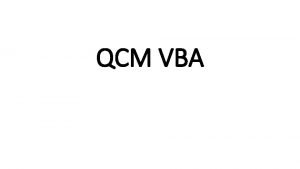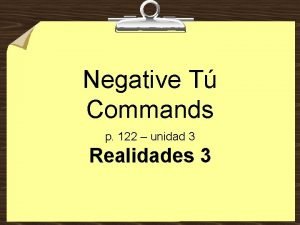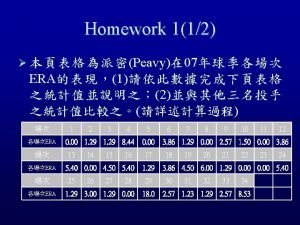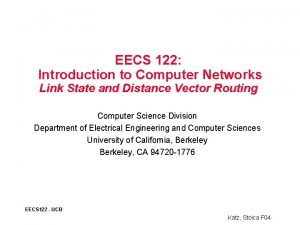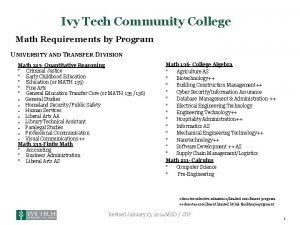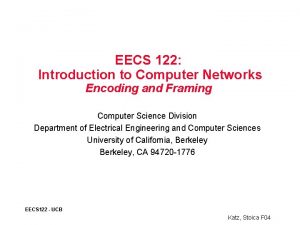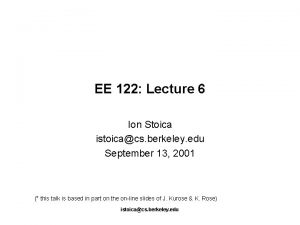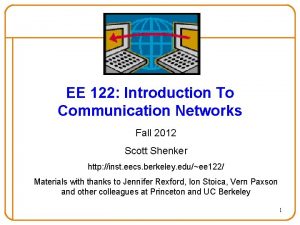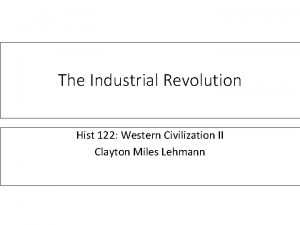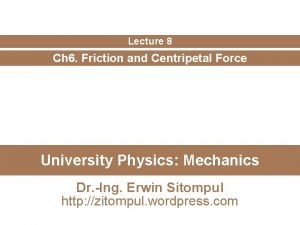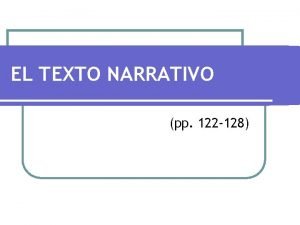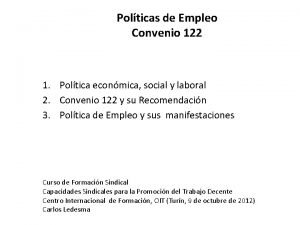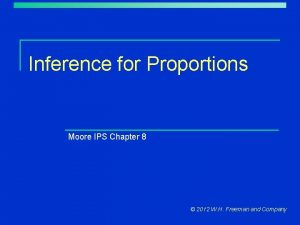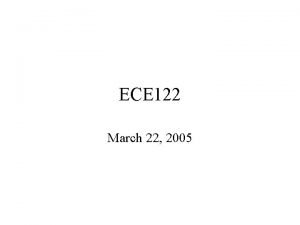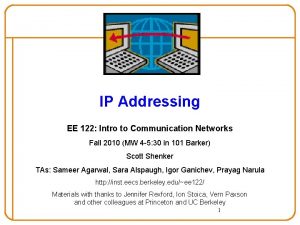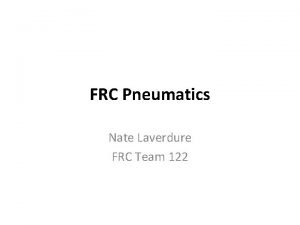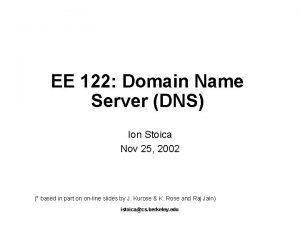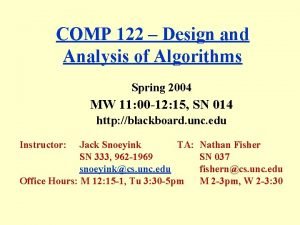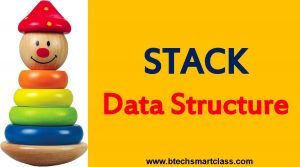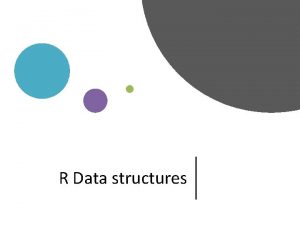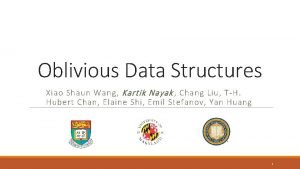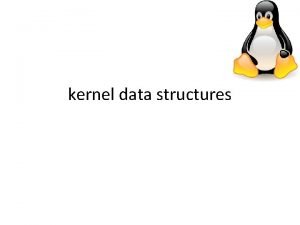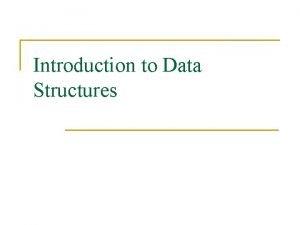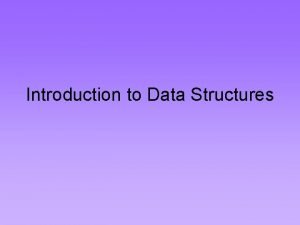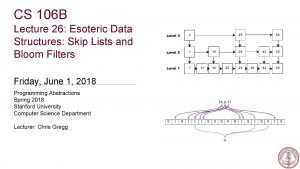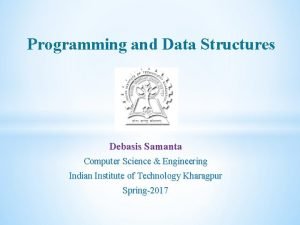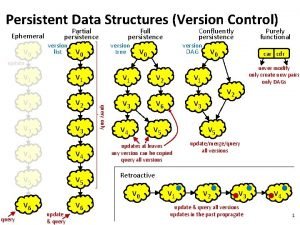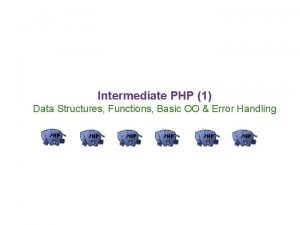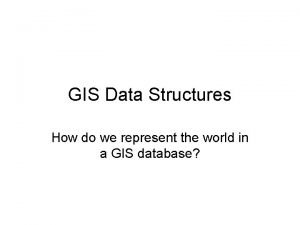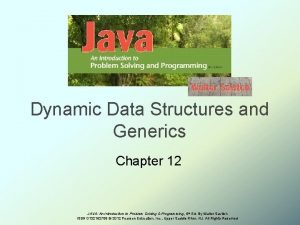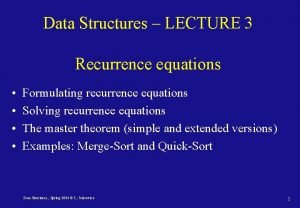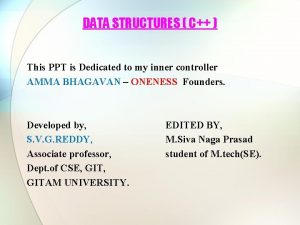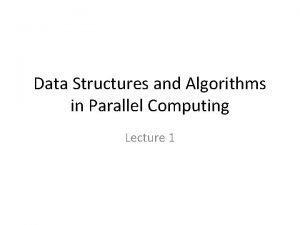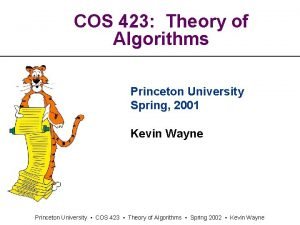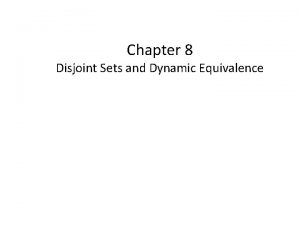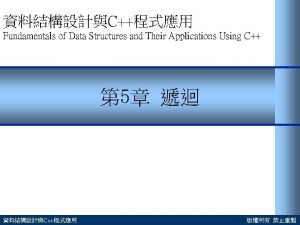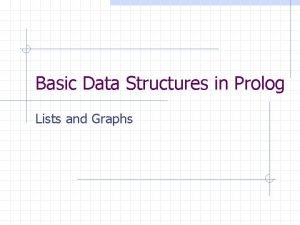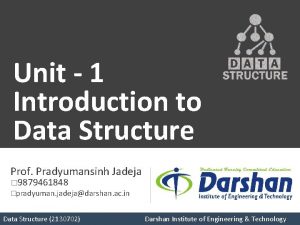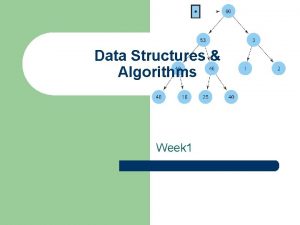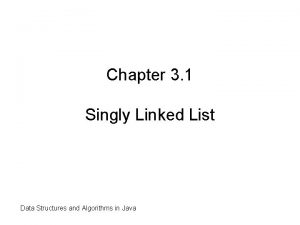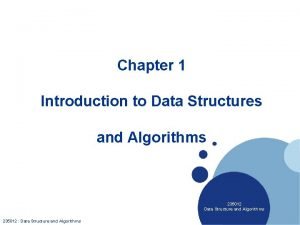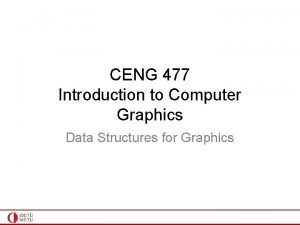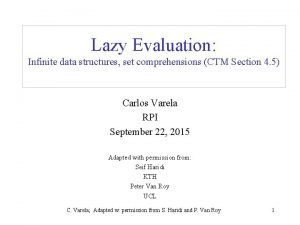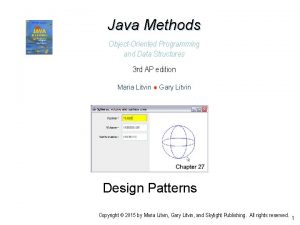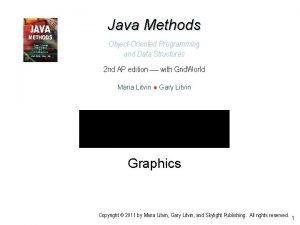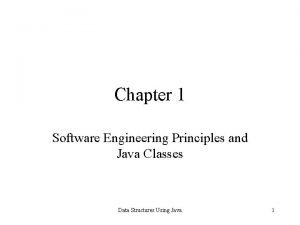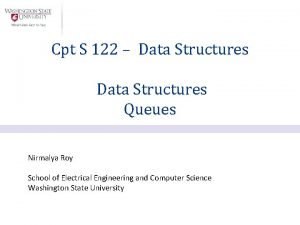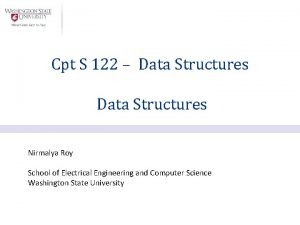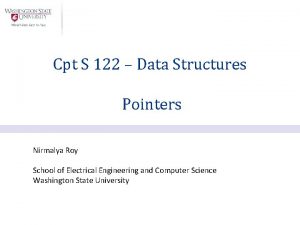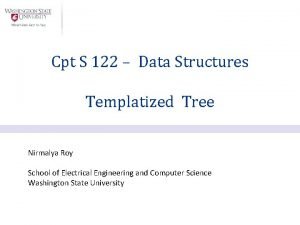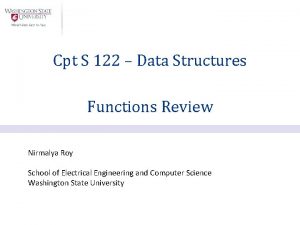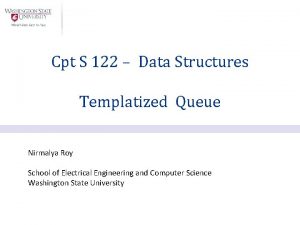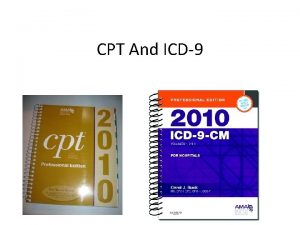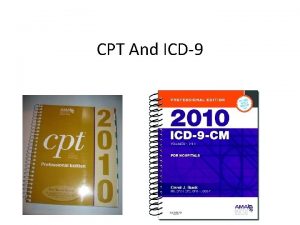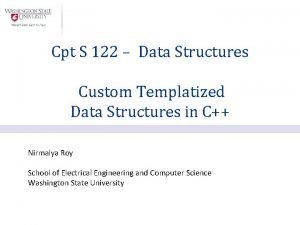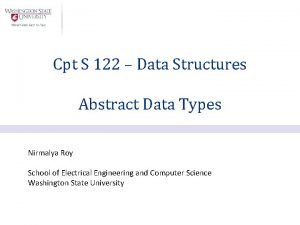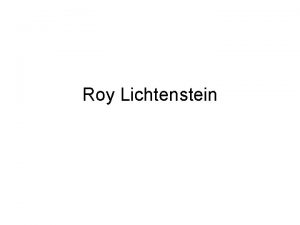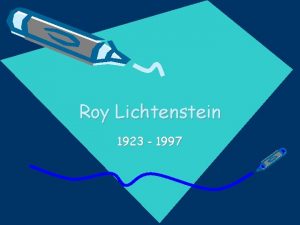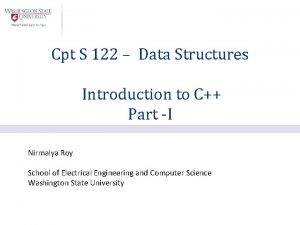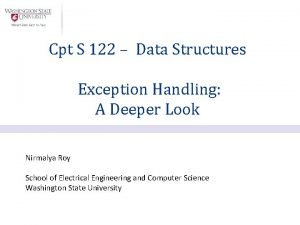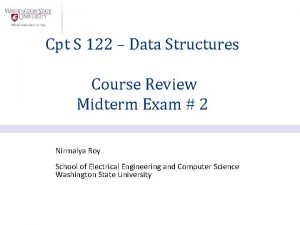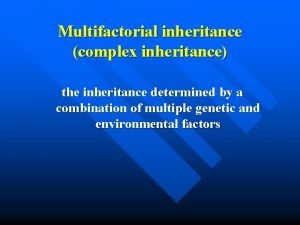Cpt S 122 Data Structures Inheritance Nirmalya Roy
























































































- Slides: 88

Cpt S 122 – Data Structures Inheritance Nirmalya Roy School of Electrical Engineering and Computer Science Washington State University

Topics n n n Introduction Base Classes & Derived Classes Relationship between Base Classes & Derived Classes ¡ ¡ n n Without and With Inheritance using Protected & Private data public, protected, and private Inheritance Software Engineering Practice with Inheritance

Introduction n Inheritance is a form of software reuse ¡ n n The new class should inherit the members of an existing class. This existing class is called the base class ¡ n n n you create a class that absorbs an existing class’s data and behaviors and enhances them with new capabilities. the new class is referred to as the derived class. A derived class represents a more specialized group of objects. A derived class contains behaviors inherited from its base class and can contain additional behaviors. A derived class can also customize behaviors inherited from the base class.

Introduction (cont. ) n A direct base class ¡ n An indirect base class ¡ n inherited from two or more levels up in the class hierarchy. In the case of single inheritance ¡ n the base class from which a derived class explicitly inherits. a class is derived from one base class. C++ also supports multiple inheritance ¡ a derived class inherits from multiple (possibly unrelated) base classes.

Introduction (cont. ) n n n C++ offers public, protected and private inheritance. With public inheritance, every object of a derived class is also an object of that derived class’s base class. However, base-class objects are not objects of their derived classes. private inheritance can be used as an alternative to composition. protected inheritance, is rarely used.

Introduction (cont. ) n n n With object-oriented programming, we focus on the commonalities among objects in the system rather than on the special cases. We distinguish between the is-a relationship and the has-a relationship. The is-a relationship represents inheritance. ¡ n In an is-a relationship, an object of a derived class also can be treated as an object of its base class. By contrast, the has-a relationship represents composition.

Introduction (cont. ) n Derived-class member functions might require access to ¡ n n A derived class can access the non-private members of its base class. Base-class members that should not be accessible to the member functions of derived classes ¡ n base-class data members and member functions. should be declared private in the base class. A derived class can change the values of private baseclass members, ¡ only through non-private member functions provided in the base class and inherited into the derived class.

Variety of Inheritance A B Single Inheritance A B C Multilevel Inheritance D Hierarchical Inheritance A B C A A B C D Hybrid Inheritance B C Multiple Inheritance

Defining Derived Classes class derived-class name : visibility-mode base-class name { ……. // members of derived class ……. . // }; Visibility mode specifies whether the features of the base class are privately derived or publicly derived n The default visibility mode is private n

Examples: Class ABC : private XYZ { …members of ABC }; //private derivation Class ABC : public XYZ { …members of ABC }; //public derivation Class ABC : XYZ //private derivation by default {…members of ABC };

Inheritance Accessibility n A base class is privately inherited ¡ ¡ ¡ n public members of the base class become private members of the derived class. public members of the base class can only be accessed by the member functions of the derived class. They are inaccessible to the objects of the derived class. A base class is publicly inherited ¡ ¡ ¡ public members of the base class become public members of the derived class. They are accessible to the objects of the derived class. In both the cases, the private members are not inherited n The private members of a base class will never become the members of its derived class.

Base Classes and Derived Classes n Often, an object of one class is an object of another class. ¡ ¡ For example, in geometry, a rectangle is a quadrilateral (as are squares, parallelograms and trapezoids). Thus, in C++, class Rectangle can be said to inherit from class Quadrilateral. In this context, class Quadrilateral is a base class, and class Rectangle is a derived class. A rectangle is a specific type of quadrilateral, but it’s incorrect to claim that a quadrilateral is a rectangle n the quadrilateral could be a parallelogram or some other shape.

Example: Base Classes & Derived Classes

Base Classes and Derived Classes (cont. ) n n n n A simple inheritance hierarchy with five levels is shown in the next Fig. A university community has thousands of members. Employees are either faculty members or staff members. Faculty members are either administrators (such as deans and department chairpersons) or teachers. Some administrators, however, also teach classes. Note that we’ve used multiple inheritance to form class Administrator. Teacher. Also, this inheritance hierarchy could contain many other classes.

Multiple Inheritance: Base Classes and Derived Classes

Base Classes and Derived Classes (cont. ) n Each arrow in the hierarchy represents an is-a relationship. ¡ ¡ ¡ n As we follow the arrows in this class hierarchy, we can state “an Employee is a Community. Member” and “a Teacher is a Faculty member. ” Community. Member is the direct base class of Employee, Student and Alumnus. Community. Member is an indirect base class of all the other classes in the diagram. Starting from the bottom of the diagram, you can follow the arrows and apply the is-a relationship to the topmost base class. ¡ An Administrator. Teacher is an Administrator, is a Faculty member, is an Employee and is a Community. Member.

Example: Base Classes & Derived Classes n n n The Shape inheritance hierarchy in next Figure. Begins with base class Shape. Classes Two. Dimensional. Shape and Three. Dimensional. Shape derive from base class Shape ¡ n n Shapes are either Two. Dimensional. Shapes or Three. Dimensional. Shapes. The third level of this hierarchy contains some more specific types of Two. Dimensional. Shapes and Three. Dimensional. Shapes. Follow the arrows from the bottom of the diagram to the topmost base class in this class hierarchy to identify several is-a relationships.


protected Members n n n n Introduced access specifiers public and private. A base class’s public members are accessible within its body and anywhere that the program has a handle (i. e. , a name, reference or pointer) to an object of that class or one of its derived classes. A base class’s private members are accessible only within its body and to the friends of that base class. Now we introduce the access specifier protected. Using protected access offers an intermediate level of protection between public and private access. A base class’s protected members can be accessed within the body of that base class, by members and friends of that base class, and by members and friends of any classes derived from that base class. Derived-class member functions can refer to public and protected members of the base class simply by using the member names.

protected Members n When a derived-class member function redefines a base-class member function, the base-class member can be accessed from the derived class ¡ by preceding the base-class member name with the baseclass name and the binary scope resolution operator (: : ).

Relationship between Base Classes and Derived Classes n We use an inheritance hierarchy containing types of employees in a company’s payroll application ¡ n n discuss the relationship between a base class and a derived class. Commission employees (who will be represented as objects of a base class) are paid a percentage of their sales, Base-salaried commission employees (who will be represented as objects of a derived class) receive a base salary plus a percentage of their sales.

Example: Base Class & Derived Class n n n Commission. Employee’s class definition. Commission. Employee’s public services include a constructor and member functions earnings and print. Also includes public get and set functions that manipulate the class’s data members first. Name, last. Name, social. Security. Number, gross. Sales and commission. Rate. ¡ ¡ These data members are private, so objects of other classes cannot directly access this data. Declaring data members as private and providing nonprivate get and set functions to manipulate and validate the data members helps enforce good software engineering.









Commission. Employee Class n The Commission. Employee constructor definition purposely does not use member-initializer syntax in the first several examples of this section, so that we can demonstrate how private and protected specifiers affect member access in derived classes. ¡ n n Later in this section, we’ll return to using member-initializer lists in the constructors. Member function earnings calculates a Commission. Employee’s earnings. Member function print displays the values of a Commission. Employee object’s data members




Creating a Class Without Using Inheritance n We now discuss the second part of our introduction to inheritance by creating and testing ¡ a completely new and independent class Base. Plus. Commission. Employee, n contains a first name, last name, social security number, gross sales amount, commission rate and base salary.

Base. Plus. Commission. Employee Class










A Class Without Using Inheritance n The Base. Plus. Commission. Employee header specifies class Base. Plus. Commission. Employee’s public services ¡ ¡ n Note the similarity between this class and class Commission. Employee ¡ n include the Base. Plus. Commission. Employee constructor and member functions earnings and print. public get and set functions for the class’s private data members first. Name, last. Name, social-Security. Number, gross. Sales, commission. Rate and base. Salary. we won’t yet exploit that similarity. Class Base. Plus. Commission. Employee’s earnings member function computes the earnings of a base-salaried commission employee.




A Class Without Using Inheritance n n Most of the code for class Base. Plus. Commission. Employee is similar, if not identical, to the code for class Commission. Employee. In class Base. Plus. Commission. Employee, ¡ n private data members first. Name and last. Name and member functions set. First. Name, get. First. Name, set. Last. Name and get. Last. Name are identical to those of class Commission. Employee. Both classes contain private data members ¡ social. Security. Number, commission. Rate and gross. Sales, as well as get and set functions to manipulate these members.

A Class Without Using Inheritance n The Base. Plus. Commission. Employee constructor is almost identical to that of class Commission. Employee, ¡ n The other additions to class Base. Plus. Commission. Employee are private data member ¡ n except that Base. Plus. Commission. Employee’s constructor also sets the base. Salary and member functions set. Base. Salary and get. Base. Salary. Class Base. Plus. Commission. Employee’s print member function is nearly identical to that of class Commission. Employee, ¡ except that Base. Plus. Commission. Employee’s print also outputs the value of data member base. Salary.

A Class Without Using Inheritance n We literally copied code from class Commission. Employee and pasted it into class Base. Plus. Commission. Employee, ¡ n n This “copy-and-paste” approach is error prone and time consuming. Worse yet, it can spread many physical copies of the same code throughout a system ¡ n modified class Base. Plus. Commission. Employee to include a base salary and member functions. creating a code-maintenance nightmare. If changes are required, make the changes only in the base class ¡ Derived classes then inherit the changes.

A Class Using Inheritance Hierarchy n n n Now we create and test a new Base. Plus. Commission. Employee class that derives from class Commission. Employee In this example, a Base. Plus. Commission. Employee object is a Commission. Employee (because inheritance passes on the capabilities of class Commission. Employee), but class Base. Plus. Commission. Employee also has data member base. Salary. The colon (: ) of the class definition indicates inheritance. Keyword public indicates the type of inheritance. As a derived class (formed with public inheritance), Base. Plus. Commission. Employee inherits all the members of class Commission. Employee, except for the constructor ¡ each class provides its own constructors that are specific to the class.

A Class Using Inheritance Hierarchy n n Destructors, too, are not inherited Thus, the public services of Base. Plus. Commission. Employee include ¡ ¡ n its constructor the public member functions inherited from class Commission. Employee we cannot see these inherited member functions in Base. Plus. Commission. Employee’s source code they’re nevertheless a part of derived class Base. Plus. Commission. Employee. The derived class’s public services also include member functions set. Base. Salary, get. Base. Salary, earnings and print.


Header file Inclusion n n Notice that we #include the base class’s header in the derived class’s header. This is necessary for three reasons. ¡ ¡ ¡ The derived class uses the base class’s name, so we must tell the compiler that the base class exists. The compiler uses a class definition to determine the size of an object of that class. A client program that creates an object of a class must #include the class definition to enable the compiler to reserve the proper amount of memory for the object. The compiler must determine whether the derived class uses the base class’s inherited members properly.

Declaration: Derived Class



Derived class cannot access Base class private data



Creating a Class Using Inheritance Hierarchy n n Shows Base. Plus. Commission. Employee’s memberfunction implementations. The constructor introduces base-class initializer syntax, which uses a member initializer to pass arguments to the base-class constructor. C++ requires that a derived-class constructor call its base-class constructor to initialize the base-class data members that are inherited into the derived class. If Base. Plus. Commission. Employee’s constructor did not invoke class Commission. Employee’s constructor explicitly, C++ would attempt to invoke class Commission. Employee’s default constructor ¡ but the class does not have such a constructor, so the compiler would issue an error.

Accessing private Data in Base Class n The compiler generates errors because base class Commission. Employee’s data members commission. Rate and gross. Sales are private ¡ n n The compiler issues additional errors of Base. Plus. Commission. Employee’s print member function for the same reason. C++ rigidly enforces restrictions on accessing private data members, ¡ n derived class Base. Plus. Commission. Employee’s member functions are not allowed to access base class Commission. Employee’s private data. even a derived class (which is intimately related to its base class) cannot access the base class’s private data. Example emphasizes that a derived class’s member functions cannot access its base class’s private data.

Accessing private data in base-class using base-class member function n The errors in Base. Plus. Commission. Employee could have been prevented by using ¡ n the get member functions inherited from class Commission. Employee. For example, we could have invoked get. Commission. Rate and get. Gross. Sales to access ¡ Commission. Employee’s private data members commission. Rate and gross. Sales, respectively.

Inheritance Hierarchy Using protected Data n n To enable class Base. Plus. Commission. Employee to directly access Commission. Employee data members first. Name, last. Name, social. Security. Number, gross. Sales and commission. Rate, we can declare those members as protected in the base class. A base class’s protected members can be accessed ¡ ¡ by members and friends of the base class and by members and friends of any classes derived from that base class.

Inheritance Hierarchy Using protected Data n n Class Commission. Employee now declares data members first. Name, last. Name, social. Security. Number, gross. Sales and commission. Rate as protected rather than private. The member-function implementations are identical.



Using protected Data n n Base. Plus. Commission. Employee inherits from class Commission. Employee. Objects of class Base. Plus. Commission. Employee can access inherited data members that are declared protected in class Commission. Employee ¡ n n data members first. Name, last. Name, social. Security. Number, gross. Sales and commission. Rate As a result, the compiler does not generate errors when compiling the Base. Plus. Commission. Employee earnings and print member function definitions. Objects of a derived class also can access protected members in any of that derived class’s indirect base classes.

Using protected Data n Inheriting protected data members slightly increases performance, ¡ n we can directly access the members without incurring the overhead of calls to set or get member functions. In most cases, it’s better to use private data members to encourage proper software engineering, ¡ leave code optimization issues to the compiler.

Using protected Data n Using protected data members creates two serious problems. ¡ ¡ ¡ n With protected data members in the base class, if the base-class implementation changes, ¡ n The derived-class object does not have to use a member function to set the value of the base class’s protected data member. Derived-class member functions are more likely to be written so that they depend on the base-class implementation. Derived classes should depend only on the base-class services (i. e. , non-private member functions) and not on the base-class implementation. we may need to modify all derived classes of that base class. Such software is said to be fragile or brittle, ¡ a small change in the base class can “break” derived-class implementation.

Base class data members are protected

Inheritance Hierarchy Using private Data n In the Commission. Employee constructor implementation, ¡ n we use member initializers to set the values of members first. Name, last. Name and social. Security. Number. We show derived-class Base. Plus. Commission. Employee can invoke nonprivate base-class member functions ¡ set. First. Name, get. First. Name, set. Last. Name, get. Last. Name, set. Social. Security. Number and get. Social. Security. Number to manipulate these data members.







Inheritance Hierarchy Using private Data n Class Base. Plus. Commission. Employee has several changes to its member-function implementations ¡ n distinguish it from the previous version of the class. Member functions earnings and print ¡ each invoke get. Base. Salary to obtain the base salary value.




Inheritance Hierarchy Using private Data n Class Base. Plus. Commission. Employee’s earnings function redefines class Commission. Employee’s earnings member function to calculate the earnings of a base-salaried commission employee. ¡ It also calls Commission. Employee’s earnings function. ¡ Note the syntax used to invoke a redefined base class member function from a derived class n ¡ n place the base-class name and the binary scope resolution operator (: : ) before the base-class member-function name. Good software engineering practice: If an object’s member function performs the actions needed by another object, we should call that member function rather than duplicating its code body. By using inheritance and by calling member functions that hide the data and ensure consistency, ¡ We can efficiently and effectively constructed a well-engineered class.

Base-class member accessibility in a derived class

Conclusions: Software Engineering with Inheritance n We use inheritance to create a new class from an existing one, ¡ n We can customize the new class to meet our needs ¡ n n the new class inherits the data members and member functions of the existing class. including additional members and redefining base-class members. The derived-class programmer does this in C++ without accessing the base class’s source code. The derived class must be able to link to the base class’s object code.

Conclusions n n Software developers can develop proprietary classes for sale or license. Users then can derive new classes from these library classes rapidly and without accessing the proprietary source code. The software developers need to supply the headers along with the object code. The availability of substantial and useful class libraries delivers the maximum benefits of software reuse through inheritance.
 Qcm vba
Qcm vba Homologous structures example
Homologous structures example Mandatos negativos con tú (p. 122)
Mandatos negativos con tú (p. 122) Nec 250 122
Nec 250 122 Hyponomy
Hyponomy Homework 122
Homework 122 Eecs 122
Eecs 122 Ece 122
Ece 122 Notice to amend assessment
Notice to amend assessment Ivy tech math 135
Ivy tech math 135 Eecs 122
Eecs 122 Nec 250 122
Nec 250 122 65/5
65/5 Psalm 122 i was glad
Psalm 122 i was glad Ion stoica berkeley
Ion stoica berkeley Ee 122
Ee 122 Ee 122
Ee 122 Class f airspace
Class f airspace Psalms 68 tpt
Psalms 68 tpt Abseetism
Abseetism Hist 122
Hist 122 Round 763 to the nearest hundred
Round 763 to the nearest hundred Psalm 69:24
Psalm 69:24 Nrs 122
Nrs 122 A traffic light weighing 122 n hangs from a cable
A traffic light weighing 122 n hangs from a cable 건설업 gdp 비중
건설업 gdp 비중 Texto en 3ra persona
Texto en 3ra persona Convenio 122 oit
Convenio 122 oit You buy a package of 122 smarties
You buy a package of 122 smarties Ece 122
Ece 122 Ee 122
Ee 122 Horas extras nocturnas lottt
Horas extras nocturnas lottt Psalm 122:1-9
Psalm 122:1-9 Harga 3 lusin pensil rp45.000 harga 32 pensil adalah
Harga 3 lusin pensil rp45.000 harga 32 pensil adalah In ip addressing, an address beginning with 122 is
In ip addressing, an address beginning with 122 is Team 122
Team 122 Ee dns servers
Ee dns servers Uncblackboard
Uncblackboard Btechsmartclass
Btechsmartclass Types of data structures in r
Types of data structures in r Oblivious data structures
Oblivious data structures Linux kernel data structures
Linux kernel data structures Introduction to data structures
Introduction to data structures Introduction to data structures
Introduction to data structures Ajit diwan
Ajit diwan Esoteric data structures
Esoteric data structures Geometric data structures
Geometric data structures Kevin wayne princeton
Kevin wayne princeton Data structures and algorithms tutorial
Data structures and algorithms tutorial Hadoop i/o compression
Hadoop i/o compression Features of macro processor
Features of macro processor Advanced data structures in java
Advanced data structures in java Assembler data structures
Assembler data structures Samantacomputer
Samantacomputer Persistent vs ephemeral data structures
Persistent vs ephemeral data structures Php data structures
Php data structures What is data structure in gis
What is data structure in gis Information retrieval data structures and algorithms
Information retrieval data structures and algorithms Dynamic data structure in java
Dynamic data structure in java Recurrence data structures
Recurrence data structures Data structures in c ppt
Data structures in c ppt Data structures for parallel computing
Data structures for parallel computing Data structures and abstractions with java
Data structures and abstractions with java Data structures for language processing
Data structures for language processing Data structures and algorithms bits pilani
Data structures and algorithms bits pilani Data structures princeton
Data structures princeton Smart union algorithm in data structure
Smart union algorithm in data structure Stacks in data structures
Stacks in data structures Fundamentals of data structures in c
Fundamentals of data structures in c Data structures in prolog
Data structures in prolog How to calculate time complexity in data structure
How to calculate time complexity in data structure Representation of polynomial using linked list
Representation of polynomial using linked list Adts, data structures, and problem solving with c++
Adts, data structures, and problem solving with c++ Dynamic data structures
Dynamic data structures Ajit diwan iit bombay
Ajit diwan iit bombay Hybrid data structures
Hybrid data structures Graphical user interface in data structures
Graphical user interface in data structures Data structures and algorithm
Data structures and algorithm Java data structures
Java data structures Data structures chapter 1
Data structures chapter 1 Graphics data structures
Graphics data structures Algorithms + data structures = programs
Algorithms + data structures = programs Infinite data structures
Infinite data structures Data structures in java
Data structures in java Data structures in java
Data structures in java Data structures and algorithms
Data structures and algorithms Data structures and algorithms
Data structures and algorithms Data structures using java
Data structures using java Data structures using java
Data structures using java
